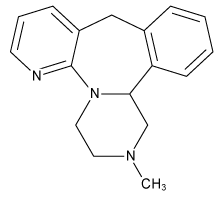| Revision as of 01:26, 7 April 2004 editDrBob (talk | contribs)3,376 edits Add example structure diagram← Previous edit | Revision as of 23:51, 9 April 2004 edit undoD3 (talk | contribs)1,466 editsm replacing text with {msg:stub}Next edit → | ||
| Line 13: | Line 13: | ||
| There are also several chemically unrelated tetracyclic ]s based on ]. | There are also several chemically unrelated tetracyclic ]s based on ]. | ||
| ''This article is a ]. You can help Misplaced Pages by ].'' | |||
| {{msg:stub}} | |||
Revision as of 23:51, 9 April 2004
 The structure of the tetracyclic
The structure of the tetracyclic antidepressent mirtazapine
A tetracyclic antidepressant is an antidepressant drug from the tetracyclic drug group.
The name tetracyclic is derived from the drug's molecular structure which consists of four ring like structures (compare tricyclic antidepressant).
Maprotiline, trade named Ludiomil®, and Mirtazapine, trade named Remeron®, are the only two drugs from this group widely used for the treatment of clinical depression. The tetracyclic antidepressant Mianserin was previously available internationally, however in most markets it has been phased out in favor of Mirtazepine. Research on other tetracyclic antidepressant compounds (for example setiptiline) have been reported in the scientific literature but are not publicly available.
There are also several chemically unrelated tetracyclic antibiotics based on Tetracycline.
This article is a stub. You can help Misplaced Pages by expanding it. |